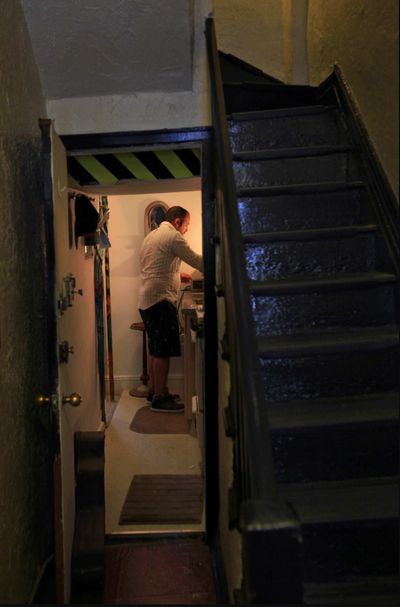Extreme downsizing
Tiny dwellings gain a big-city following

NEW YORK – Scott Elyanow had clung to the red, long-sleeved sweatshirt with the words “Marblehead High School” for 20 years. It had softened with age, like the memory of the long-ago love who had given it to him.
But Elyanow was nearing 40, and what he had gained in years and wisdom he hadn’t gained in living space – his apartment measures 275 square feet, including the bathroom, kitchen and an entryway with overhead clearance of 5 feet 7 inches. So he took a picture of the sweatshirt for a keepsake, then tossed the worn piece of clothing into a “purge” pile, a system Elyanow has adopted during his seven years living in a so-called micro-studio apartment in New York City.
“I really, truly don’t accumulate stuff,” said Elyanow, a real estate agent with Citi Habitats. He lives and works in Manhattan’s West Village, where the crooked, cobblestoned streets are lined with 19th century buildings famous for charming but cramped apartments.
If Mayor Michael R. Bloomberg has his way, the city soon will have far more tiny apartments to accommodate a burgeoning need for smaller, cheaper living spaces.
“Today there are about 1.8 million one- and two-person households in the city, but there are only about 1 million studio and one-bedroom apartments. You notice the mismatch,” Bloomberg said in July as he announced a competition for designing a building dominated by microstudios.
The building will be part of a pilot program called adAPT NYC, which could create a new housing model for America’s biggest city – showing that small doesn’t necessarily mean dark, dismal and musty. The winning design must include apartments no larger than 300 square feet, including a kitchen, a bathroom with a tub, and windows that look out on air, not air shafts. The city won’t pay for the construction but will provide the space: a city-owned lot on Manhattan’s East 27th Street currently used for parking. The winner will be announced later in the year.
Nationwide census figures bear out what New York officials say is a trend toward solo living. In 2010, 28 percent of U.S. households were single-person; in 1950, it was 9.5 percent. In New York City, the percentage of single-person households is 32 percent.
New York isn’t the only city to experiment with microunits. San Francisco is considering shrinking the minimum for rental units from 290 to 220 square feet. At the urging of Boston’s mayor, some new buildings containing that city’s version of a microstudio – smaller than 450 square feet – are being built.
New York’s plan has grabbed special attention because of the city’s reputation as a place where people already live in minuscule homes and because of Bloomberg’s reputation as a social engineer bent on transforming Gotham from a chaotic metropolis into a more European-style model of civility. He has turned Times Square into a pedestrian mall, replaced precious parking spaces with bike lanes, banned smoking in most public places, and cracked down on trans fats in restaurant and deli foods.
Now comes this, a plan that by virtue of New York’s size and influence could prompt other high-density urban areas to address the need for “right-sized housing,” as the city’s Department of Housing and Urban Development puts it.
“It makes sense to try this out,” Bloomberg said before walking over to a mock-up floor plan for one of the New York units and demonstrating the – er – ease with which one might step from bed to bath in a 10-by-30-foot space.
That’s only six times larger than the average jail cell, or about the size of some ATM vestibules in Times Square, local media pointed out as they noted the irony of the billionaire mayor, who lives in a spacious town house, singing the praises of diminutive dwellings.
What’s tiny to some, though, is grand to people like Ryan Mitchell, who advocates drastic downsizing on his website, thetinylife.com, and offers tips on how to squeeze yourself happily into 100 to 200 square feet.
“I realize that is an extreme,” said Mitchell, 28, of Charlotte, N.C. He currently occupies what he calls a “normal-sized” home while he saves to build himself a tiny house there that will have 130 square feet of living space on two levels.
“I don’t expect and I don’t think the majority of us will get to a point where we’re living in that type of dwelling,” Mitchell said. “But I think it’s important to show there’s an alternative to McMansions.”